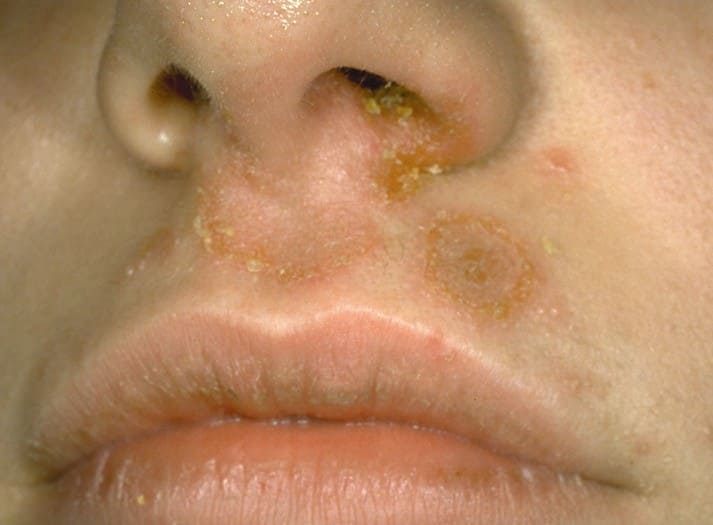What are staphylococci
Staphylococci are gram-positive bacteria that are normally found in the nose and on the surface of the skin.
If they enter the body through a wound, for example, these bacteria can defeat the body’s natural defense system, causing an infection that manifests itself in different ways.
There are over 30 types of staphylococci, but most infections are caused by golden staphylococcus (Staphylococcus aureus), which is most resistant to antibiotics and can be even lethal.
Boils, cellulite, impetigo, and food poisoning are just a few of the conditions caused by a staph infection. Depending on the location of the infection, symptoms may consist of collections of pus under the skin (abscesses), pain, inflammation, diarrhea, vomiting, etc.
The categories most prone to staphylococcal infections and which are at increased risk of complications are people suffering from chronic diseases (diabetes, cancer, lung disease), newborns, breastfeeding women and injecting drug users.
It should be noted that the person infected with a staphylococcus can transmit the infection to other people, through direct contact with an infected wound, sharing the objects for personal use (razor blades, for example).
The treatment of staphylococcal infections usually consists of antibiotics and/or topical application of antibiotic ointments, but other interventions may be required, depending on the severity of the symptoms and the type of infection.
Staphylococcal infection: symptoms
The symptoms of staphylococcal infection depend on the affected area. These can be mild, moderate or severe, depending on the health status of the infected person and consist of:
- Abscesses (pus collections) in the form of boils (usually located in the groin area, on the inside of the thighs, on the underarm or sometimes between the buttocks, and on the breasts), pain, redness, and swelling of the area – when the staphylococcal infection is present at the skin level
- Fever and/or chills, low blood pressure, accelerated breathing, excessive sweating, weight loss – when staphylococcus enters the bloodstream and reaches vital organs, such as brain, heart or lungs.
- Nausea, vomiting, diarrhea, dehydration, hypotension – when the infection is caused by ingestion of food contaminated with staphylococci
- Muscle pain, confusion, increased fever, vomiting, diarrhea, abdominal pain – symptoms specific to toxic shock syndrome, a severe staphylococcal infection, sometimes associated with the use of tampons
- Joint pain, fever, stiff and swollen joints – when the staph infection is localized to the knees, shoulders, hips or fingers of the hands or feet

Among the conditions commonly caused by staphylococcal infections include:
- boils
- cellulite
- impetigo
- scraped skin syndrome
- food poisoning
- mastitis
- sepsis
- toxic shock syndrome
- endocarditis
- osteomyelitis
- thrombophlebitis
- pneumonia
Staphylococcal infection: causes
Many people are only carriers of staphylococci and do not develop an infection. This occurs when the bacterium reaches the body through open cuts, scratches or wounds and can be superficial, deep in the skin, or deep in the internal organs.
Staphylococci are extremely resistant bacteria, which can survive in very dry environments, at very high or, on the contrary, very low temperatures, gastric acid or increased salt levels.

However, a number of factors may increase the risk of developing a staph infection:
- certain medical conditions (diabetes, HIV/AIDS infection, kidney failure, cancer, cystic fibrosis, pulmonary emphysema )
- long-term hospitalization
- surgery
- burns
- chemotherapy
- certain medical procedures (dialysis, urinary catheterization, feeding tubes, intravascular catheterization, artificial respiration devices)
- contact sports
- sharing razor blades, nails or towels
- food preparation with dirty hands
- use a tampon for a long time
- breastfeeding (bacteria in the baby’s mouth can penetrate into the breast tissue through a crack)
- dental caries or dental bleeding
Staphylococcal infection: diagnosis
Staphylococcal infection of the skin can be easily diagnosed, based on the signs and symptoms, without the need for laboratory tests. Sometimes, however, the doctor may decide to take an abscess sample to determine precisely the type of bacteria and, by implication, the most effective treatment.
Food poisoning caused by a staphylococcus can be diagnosed on the basis of a stool sample (co-culture) and digestive symptoms.
Urine and blood tests, computed tomography and echocardiogram are other investigations that may be recommended by the doctor for the detection of staph infection and its complications.

Staphylococcal infection: treatment
Skin lesions caused by a staph infection can be easily treated with an antibiotic ointment. Sometimes oral or intravenous administration of antibiotics may be necessary, especially if the infection is widespread. If there are abscesses, the doctor may drain the surgical pus.
The most commonly used antibiotics for staphylococcal infection include cefazolin, cefuroxime, cefalexin, naphthylline, oxacillin, dicloxacillin, vancomycin, clindamycin, rifampicin, and telavancin.
However, such drugs can also have side effects such as redness, itching, nausea, vomiting or diarrhea.
Staphylococcal infection: prevention
Staphylococcal infection cannot be prevented by vaccination, such as influenza, but measures can be taken to prevent certain risk factors. These may consist of:
- Washing hands thoroughly with soap and water
- Not sharing personal care items (razor blades, towels, nails, etc.)
- Changing the vaginal swab every 4-8 hours
- Immediate disinfection of wounds, cuts, scratches, and coating with a sterile bandage
- Weekly bedding with chlorine, at high temperatures








